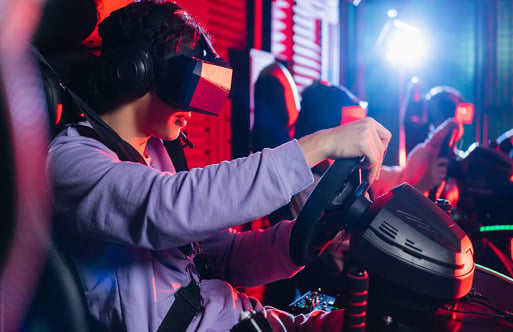Is there a story behind the skull-like robot behind you?
This is Morgui and Morgui has five senses which are vision, audio, ultra-sonics, radar and infrared and the research project is to fuse the different sensory input together. A lot of artificial intelligence just have one sense, maybe as a vision sensor on a robot, and you can interrupt it if the robot touches something and the robot takes over and the vision stops.
But what we’re trying to do here is a bit like how human brains work and that is to integrate the information together. But Morgui, because of the cameras, can record images and respond to those images.
At the moment it’s just got it going through a routine and what we can get it to do is to pick up anything really, visually, that it can then track but can use infrared, which is like a heat signal to track. So things like bodies moving around. We did have a problem with one of the cleaners here coming in first thing in the morning and it saw her. We left it on overnight, and it followed her around because of her body heat, so everywhere she went the robot was looking at her so we got into all sorts of trouble with that so we had to switch it off every night.
Morgui has, you see, the blue eyes where they got cameras in the eyes, of course you can then look at the computer vision and the robot can understand what it’s seeing, but it’s also got audio, almost like ears on both sides, the two black marks in the forehead are ultra-sonics, so it has a good sense of distance. It’s then got radar in its nose, which is interesting one. Radar can also be quite useful for picking up distance to objects and infrared on its top lip is a little silver sensor, which is an Infrared detector. Infrared is like a heat signal so Morgui can detect heat from a distance, so if there’s an object at a certain temperature Morgui will sense that by the infrared sensor.
If the reading increases the robot doesn’t know that an object that is the same distance away is getting hotter or is an object that is moving towards it but is the same heat, so you need other sensory input for the robot to make decisions like that.
But looking at how the AI works in the robot, with different sensory inputs, it gives you more of an indication of how artificial intelligence, in a human sense, works, in terms of fusing the human sensory input.
Do you have PhD students working on this project with you?
We’ve got PhD students, several work on the rat brain robot and we’re looking to put the biological brain into Morgui’s head and actually developing the brains, culturing them in a little Petri dish type thing, keeping them alive and hence understanding, in the biological sense, the sensory input from Morgui, but also some students are working directly on the data fusion from Morgui’s senses in more of a computer silicone type sense.

















